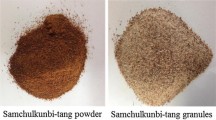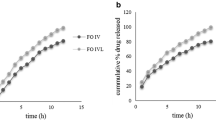Abstract
The objective of present study was to develop a gastroretentive drug delivery system of propranolol hydrochloride. The biggest problem in oral drug delivery is low and erratic drug bioavailability. The ability of various polymers to retain the drug when used in different concentrations was investigated. Hydroxypropyl methylcellulose (HPMC) K4 M, HPMC E 15 LV, hydroxypropyl cellulose (HPC; Klucel HF), xanthan gum, and sodium alginate (Keltose) were evaluated for their gel-forming abilities. One of the disadvantages in using propranolol is extensive first pass metabolism of drug and only 25% reaches systemic circulation. The bioavailability of propranolol increases in presence of food. Also, the absorption of various drugs such as propranolol through P-glycoprotein (P-gp) efflux transporter is low and erratic. The density of P-gp increases toward the distal part of the gastrointestinal tract (GIT). Therefore, it was decided to formulate floating tablet of propranolol so that it remains in the upper part of GIT for longer time. They were evaluated for physical properties, in vitro release as well as in vivo behavior. In preliminary trials, tablets formulated with HPC, sodium alginate, and HPMC E 15 LV failed to produce matrix of required strength, whereas formulation containing xanthan gum showed good drug retaining abilities but floating abilities were found to be poor. Finally, floating tablets were formulated with HPMC K4 M and HPC.



Similar content being viewed by others
References
Singh BN, Kim KH. Floating drug delivery systems: an approach to oral controlled drug delivery via gastric retention. J Control Release. 2000;63:235–59. Review.
Chawla G, Gupta P, Bansal AK. In: Jain NK, editor. Progress in controlled and novel drug delivery. 1st ed. New Delhi: CBS; 2001. p. 76–97.
Tripathi KD. Antihypertensive drugs, essentials of medical pharmacology. 5th ed. New Delhi: Jaypee Brothers; 2003. p. 235–6.
Woodlinger AM. Cardiovascular drugs. In: Troy DB, editor. Remington the science and practice of pharmacy, Indian edition. 21st ed. Philadelphia: Lippincott Williams and Wilkins; 2005. p. 1350.
Williams DA, Temke TL. Foyes principles of medicinal chemistry, International student edition. Philadelphia: Lippincott Williams and Wilkins; 2002. p. 489–93.
Indian Pharmacopoeia. Government of India, Ministry of Health and Family Welfare, vol. II. Delhi: The Controller of Publication; 1996. p. 634.
Davis SS. Formulation strategies for absorption windows. Drug Discov Today. 2005;10(4):250.
Singh BN, Kim KH. Encyclopedia of pharmaceutical technology, drug delivery: oral route. New York: Marcel Dekker; 2001. p. 1253.
Khattar D, Ahuja A, Khar RK. Hydrodynamically balanced systems as sustained release dosage forms for propranolol hydrochloride. Pharmazie. 1990;45(5):356–8.
Bodea A, Leucuta SE. Optimization of propranolol hydrochloride sustained release pellets using factorial a design. Int J Pharm. 1997;154:49–54.
Narendra C, Srinath MS, Babu G. Optimization of bilayer floating tablet containing metoprolol tartarate as a model drug for gastric retention. AAPS Pharm Sci Tech. 2006;7(2):Article 34.
Ali J, Ahuja A, Khar RK, Baboota S. Formulation and development of hydrodynamically balanced system for metformin. Eur J Pharm Biopharm. 2007;67:196–201.
Basak SC, Rao KN, Manavalan R, Rao PR. Development and in vitro evaluation of floating matrix tablet of ciprofloxacin. Indian J Pharm Sci. 2004;66(3):313–6.
Sriamornsak P, Thirawong N, Korkard K. Swelling, erosion and release behavior of alginate-based matrix tablets. Eur. J. Pharm. Biopharm. 2007;66:435–50.
Huang YB, Tsai YH, Yang WC, Wu PC, Chang JS. Influence of formulation variables and manufacturing process on propranolol extended release profile from HPMC matrices tablets. J Appl Polymer Sci. 2004;93(4):1886–90.
Huang YB, Tsai YH, Yang WC, Wu PC, Chang JS. Optimization of sustained release propranolol dosage form using factorial design and response surface methodology. Biol Pharm Bull. 2004;27(10):1626–9.
Garg S, Sharma S. Gastroretentive drug delivery systems. Business briefings. Pharmatech. 2003;162.
Arora S, Ali J, Ahuja A, Khar RK, Baboota S. Floating drug delivery systems: a review. AAPS PharmSciTech. 2005;6(3):Article 47.
Baumgartner S. Optimisation of floating matrix tablets and evaluation of their gastric residence time. Int. J. Pharm. 2000;195:125–35.
Staniforth J. In: Aulton ME, editor. Pharmaceutics: the science of dosage form design. 2nd ed. London: Churchill Livingstone; 2002. p. 207–8.
USP NF. The official compendia of standards. The United States Pharmacopoeial Convention. Asian edition. Propranolol extended release capsules. 2006;3115.
Costa P, Sousa Lobo JM. Review: modeling and comparison of dissolution profiles. Eur J Pharm Sci. 2001;13:123–33.
Gohel MC, Amin AF, Patel KV, Panchal MK. Studies in release behavior of diltiazem HCl from matrix tablets containing (hydroxypropyl) methyl cellulose and xanthan gum. Boll. Chim. Farm. 2002;141:21–8.
Gambhire MN, Ambade KW, Kurmi SD, Kadam VJ, Jadhav KR. Development and in vitro evaluation of an oral floating matrix tablet formulation of diltiazem hydrochloride. AAPS PharmSciTech. 2007;8(3):Article 73.
Author information
Authors and Affiliations
Corresponding author
Rights and permissions
About this article
Cite this article
Jagdale, S.C., Agavekar, A.J., Pandya, S.V. et al. Formulation and Evaluation of Gastroretentive Drug Delivery System of Propranolol Hydrochloride. AAPS PharmSciTech 10, 1071–1079 (2009). https://doi.org/10.1208/s12249-009-9300-8
Received:
Accepted:
Published:
Issue Date:
DOI: https://doi.org/10.1208/s12249-009-9300-8




